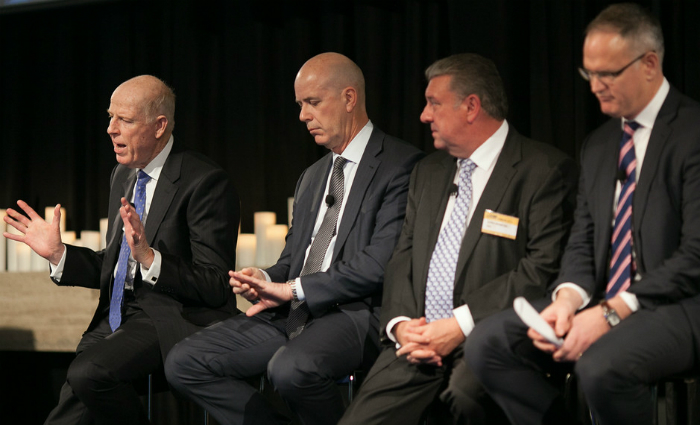
Newspapers have only themselves to blame for the perilous state of their industry, media bosses concede, with advertising revenues and circulations collapsing despite having more readers than ever.
News Corp chief executive Julian Clarke admitted at last week’s Future Forum that media buyers are not buying what newspapers are selling and the industry needs to bring more to the table.
“I think the fault there lies clearly with us. It is up to us as newspaper owners to put our hand up and make an articulate case, which I believe we can,” he said.
“The question is always, what is the value proposition, what can we bring to an advertiser or marketing agent to improve their position and move product? They are only going to spend money with us if it works.
“When you spend three quarters of an hour with a newspaper, whether it be in print or digital, you are talking about engagement. I think big advertisers who are dependent on creating store traffic, whether it is real or virtual, understand this.”
[Related: Newspapers in flux]
Clarke says while destination sites and search engines work well for an active audience – people looking for specific information – newspapers work best at convincing a passive audience to buy.
“The passive market is not looking for anything, but if Qantas want to convince me to go on a plane to LA, with a reduced price, they need to be in old media,” he says.
“We are getting a clearer picture of what works for who.”
Some 16.4 million people read newspapers either in print and digital, according to the industry’s Enhanced Media Metrics Australia (emma) readership survey’s first year-on-year report.
Despite these numbers, advertising revenues continue to fall across Australian papers. FY13 financial results for News Corp Australia leaked this week show advertising revenue for the whole company fell by $320m and one in eight jobs was cut.
Total revenue for its flagship The Australian dropped 20.2 per cent to $107.6m, with similar declines for its tabloids.
APN News and Media chief executive Michael Miller, also on the panel with Clarke, Fairfax boss Greg Hywood and West Australian Newspapers (WAN) chief executive Chris Wharton, says papers should abandon the strategy of trying to one-up other mediums with readership results.
Miller says newspapers need to work with agencies to cement their products’ place within campaigns, in tandem with other media.
“Too often we say, here is the reach of our newspapers against the reach of the TV stations. That is not the way agencies or clients think,” he says.
“They think about how a full page ad will work with digital and other media in the campaign.
“Our job is to explain the role of print in these campaigns. The old approach of ‘we’re better than others’ is not working. Our papers, in conjunction with other media, could open up a whole range of opportunities.”
Wharton says he has seen clients make failed attempts to move their advertising out of print to digital. Wesfarmers, he says, had set an objective to move its advertising out of print in three to four years, but found moving its catalogues online ‘just does not work.’
In August he says WAN ran an online auction, promoted through its newspapers, called Click to Give, which managed to haul in $2.5m for the newspaper in 10 days.
“I think that is harnessing the web, backed up with the newspaper,” he says.
While defending the power of print, though it was referred to throughout the forum as ‘old’ media, ‘traditional’ or even ‘analogue,’ the chief executives also praised the advantages of digital.
[Related: More news on the future of print]
Clarke says: “All of us in the business are working the digital world like we have not done before, we are seeing real potential there. And we are holding on to the strength of the press and all of the great things that go with it.
“The great irony is that the technology that has disrupted us has turned out to be our saviour. The newspaper business has suffered over the last twenty years from the loss of immediacy.
“We now have immediacy, combined with the best five or six best communication techniques mankind has devised – text, graphics, photography, audio, video and now transaction.
“The world we live in, which used to be two-dimensional and limited, is our oyster. Technology has released us. The limits will be the business models that we build around ourselves.”
Hywood says the revenue problem may be bypassed by finding new ways of bringing in cash, beyond subscriptions and advertising.
“The internet has given media companies, particularly us, vastly larger audiences than we have ever had before. More people read our journalism now than in the so-called glory days of print circulation,” he says.
“Clients are spending more on marketing than they ever have. They might be spending less on advertising, and on print advertising, but they want an event to connect with their audience, they want content.
“The conventional wisdom about the newspaper industry was it could not reinvent itself. It has massively reinvented itself. We are now finding new ways of making money.”
Comment below to have your say on this story.
If you have a news story or tip-off, get in touch at editorial@sprinter.com.au.
Sign up to the Sprinter newsletter
